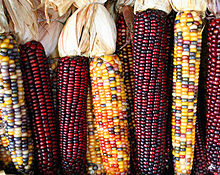Zea (plant)
| Zea | |
|---|---|
 |
|
| Zea mays | |
| Scientific classification | |
| Kingdom: | Plantae |
| (unranked): | Angiosperms |
| (unranked): | Commelinids |
| Order: | Poales |
| Family: | Poaceae |
| Subfamily: | Panicoideae |
| Tribe: | Andropogoneae |
| Genus: |
Zea L. |
| Type species | |
|
Zea mays L. |
|
| Synonyms | |
|
|
Zea is a genus of plants in the grass family. The best-known species is Z. mays, variously called maize, corn, or Indian corn, one of the most important crops for human societies over much of the world. Several wild species are commonly known as teosintes and are native to Mesoamerica.
The five recognized species in the genus are: Zea diploperennis, Zea perennis, Zea luxurians, Zea nicaraguensis, and Zea mays. The last species is further divided into four subspecies: Z. m. huehuetenangensis, Z. m. mexicana, Z. m. parviglumis, and Z. m. mays. The first three subspecies are teosintes; the last is maize, or corn, the only domesticated taxon in the genus Zea. The species are grouped into two sections, section Luxuriantes, with the first four species, and section Zea with Zea mays. The former section is typified by dark-staining knobs made up of heterochromatin that are terminal on most chromosome arms, while most subspecies of section Zea may have none to three knobs between each chromosome end and the centromere and very few terminal knobs (except Z. m. huehuetenangensis, which has many large terminal knobs). The two perennials are thought to be one species by some.
Both annual and perennial teosinte species occur. Zea diploperennis and Z. perennis are perennial, while all other species are annual. All species are diploid (n=10) with the exception of Z. perennis, which is tetraploid (n=20). The different species and subspecies of teosinte can be readily distinguished based on morphological, cytogenetic, protein, and DNA differences and on geographic origin, although the two perennials are sympatric and very similar. What many consider to be the most puzzling teosinte is Z. m. huehuetenangensis, which combines a morphology rather like Z. m. parviglumis with many terminal chromosome knobs and an isozyme position between the two sections. Considered to be phenotypically the most distinctive, as well as the most threatened, teosinte is Zea nicaraguensis. This teosinte thrives in flooded conditions along 200 m of a coastal estuarine river in northwest Nicaragua.
...
Wikipedia
